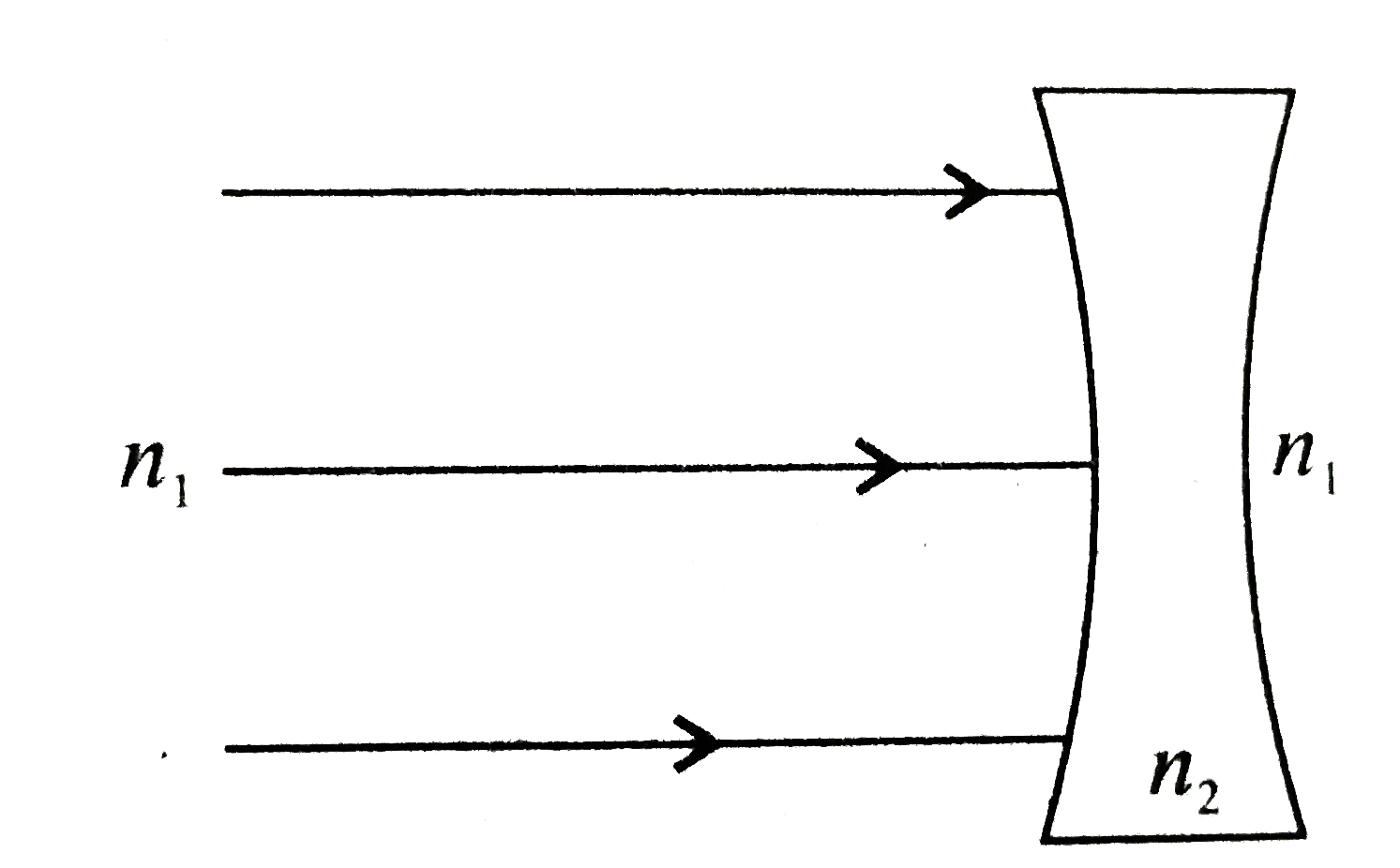A concave lens made of a material of refractive index n1 is kept in a medium of refractive index n2. A parallel beam of light is incident on the lens. Trace the path of rays of light parallel to the principal axis incident on the concave lens after refraction when:
(i) n1>n2 (ii) n1=n2
Give reason for each.Solution in Kannada

n1>n2 lens behave as diverging lens

n1=n2 no refraction occurs.
Topper's Solved these Questions
- LIGHT-REFLECTION AND REFRACTIONBOOK - OSWAAL PUBLICATIONCHAPTER - LIGHT-REFLECTION AND REFRACTIONEXERCISE - TOPIC -2 REFRACTION, LENSES, POWER OF LENS (LONG ANSWER TYPE QUESTIONS II)
15 Videos
- LIGHT-REFLECTION AND REFRACTIONBOOK - OSWAAL PUBLICATIONCHAPTER - LIGHT-REFLECTION AND REFRACTIONEXERCISE - NCERT CORNER(INTEXT QUESTIONS)
13 Videos
- LIGHT-REFLECTION AND REFRACTIONBOOK - OSWAAL PUBLICATIONCHAPTER - LIGHT-REFLECTION AND REFRACTIONEXERCISE - TOPIC -2 REFRACTION, LENSES, POWER OF LENS (SHORT ANSWER TYPE QUESTIONS I)
17 Videos
- ELECTRICITYBOOK - OSWAAL PUBLICATIONCHAPTER - ELECTRICITYEXERCISE - Textbook Exercises
22 Videos
- MAGNETIC EFFECTS OF ELECTRIC CURRENTBOOK - OSWAAL PUBLICATIONCHAPTER - MAGNETIC EFFECTS OF ELECTRIC CURRENTEXERCISE - TEXTBOOK EXERCISE
18 Videos
Similar Questions
(i) Define optical centre of spherical lens.
(ii) A divergent lens has a focal length of 20 cm. At what distance should an object of height 4 cm from the optical centre of the lens be placed so that its image is formed 10 cm away from the lens. Find the size of the image also.
(iii) Draw a ray diagram to show the formation of image in above situation.
View SolutionDefine the principal focus of a convace mirror.
View SolutionWhat is meant by power of a lens? What does its sign (+ve or -ve) indicate? State its S.I. unit. How is this unit related to focal lengths of a lens?
View SolutionA piece of wire of resistance R is cut into five equal parts. These parts are then connected in parallel. If the equivalent resistance of this combination is R' then the ratio R/R' is -
View SolutionWhich of the following correctly describes the magnetic field near a long straight wire?
View SolutionA hollow double concave lens is made of very thin transparent material. It can be filled with air or either of two liquids L_(1) or L_(2) having refractive indices n_(1) and n_(2) , respectively (n_(2) gt n_(1) gt 1) . The lens will diverge parallel beam of light if it is filles with
View SolutionThe refractive index of the material of a concave lens is n . It is immersed in a medium of refractive index n_(1) . A paprallel beam of light is incident on the lens. Trace the path of emerged rays in each of the following cases : (a) n_(1) gt n (b) n_(1) lt n ( c) n_(1) = n .
View Solutionएक अवतल लेंस के पदार्थ का अपवर्तनांक n है | यदि इसे अपवर्तनांक के द्रव में डुबा दिया जाये, तो निम्नलिखित दशाओं में एक समान्तर किरण-पुँज के लिए लेंस से निर्गत किरणों का पथ दिखाइए :
(a) n1>n
(b) n1<n
(c ) n1−n
View Solution
उपयुर्क्त चित्र में लेंस के अपवर्तन के बाद निर्गत किरण का मार्ग बनाइये यदि n1>n2 जहाँ n1 व n2 माध्यम के अपवर्तनांक है।
View SolutionA concave lens having a material of refractive index μ1 is kept in a medium of R.I. μ2, where μ1<μ2. A parallel beam of light is incident on the lens. The concave lens will act as
View SolutionA convex lens of refractive index μ1 is kept in a medium of refractive index (μ2) . A parallel beam of light is incident on the lens . Draw the path of the rays of light emerging from a lens . If μ1=μ2
View SolutionA concave lens of refractive index mu_(1) is kept in a medium of refractive index (mu_(2)) . A parallel beam of light is incident on the lens . Draw the path of the rays of light emerging from a lens . If mu_(1) = mu_(2)
View Solutionएक प्रकाश किरण माध्यम (1) से माध्यम (2) में अपवर्तित होती है| इनके अपवर्तनांक क्रमश: n1 तथा n2 है तथा n2<n1 | क्रांतिक आपतन कोण के लिए व्यंजक लिखिए|
View Solutionएक खोखला द्वि - अवतल लेंस बहुत पतले पारदर्शी माध्यम से बना है | यह वायु अथवा क्रमशः n1 तथा n2(n2>n1>1) अपवर्तनांक वाले दो द्रवों, L1 तथा L2 से भरा जा सकता है | यह लेंस प्रकाश के एक समान्तर किरण पुँज को अपसारित करेगा, यदि
View SolutionWhen a lens of refractive index n1 is placed in a liquid of refractive index n2, the lens looks to be disappeared only if
View Solution
